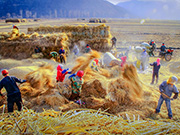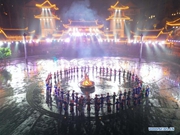

A worker prepares sheets of gold foil before grinding them into powder to make Fenlajian paper at a workshop run by paper artisan Liu Jing in Huanglu Township of Chaohu, east China's Anhui Province, May 23, 2019. Fenlajian is a high-end wax mineral paper which dates back to the Tang dynasty (618-907). For centuries, access to the Fenlajian paper had remained a privilege reserved solely for China's imperial families, due to the costly materials and the set of complicated procedures involved in its making. The techniques in producing this fine writing and painting material even became lost in the late Qing dynasty (1644-1911), until Liu Jing, an Anhui-based paper artisan, managed to revive them through constant trials by the end of the 20th century. Born in a family of paper-makers, Liu now runs a paper workshop dedicated to making Fenlajian and other classical papers while promoting their know-hows. Liu's classical paper processing techniques were listed as a national intangible cultural heritage in 2008, and he himself was named as a national representative inheritor to the aforementioned techniques in 2018. (Xinhua/Liu Junxi)
 |

 Award-winning photos show poverty reduction achievements in NE China's Jilin province
Award-winning photos show poverty reduction achievements in NE China's Jilin province People dance to greet advent of New Year in Ameiqituo Town, Guizhou
People dance to greet advent of New Year in Ameiqituo Town, Guizhou Fire brigade in Shanghai holds group wedding
Fire brigade in Shanghai holds group wedding Tourists enjoy ice sculptures in Datan Town, north China
Tourists enjoy ice sculptures in Datan Town, north China Sunset scenery of Dayan Pagoda in Xi'an
Sunset scenery of Dayan Pagoda in Xi'an Tourists have fun at scenic spot in Nanlong Town, NW China
Tourists have fun at scenic spot in Nanlong Town, NW China Harbin attracts tourists by making best use of ice in winter
Harbin attracts tourists by making best use of ice in winter In pics: FIS Alpine Ski Women's World Cup Slalom
In pics: FIS Alpine Ski Women's World Cup Slalom Black-necked cranes rest at reservoir in Lhunzhub County, Lhasa
Black-necked cranes rest at reservoir in Lhunzhub County, Lhasa China's FAST telescope will be available to foreign scientists in April
China's FAST telescope will be available to foreign scientists in April